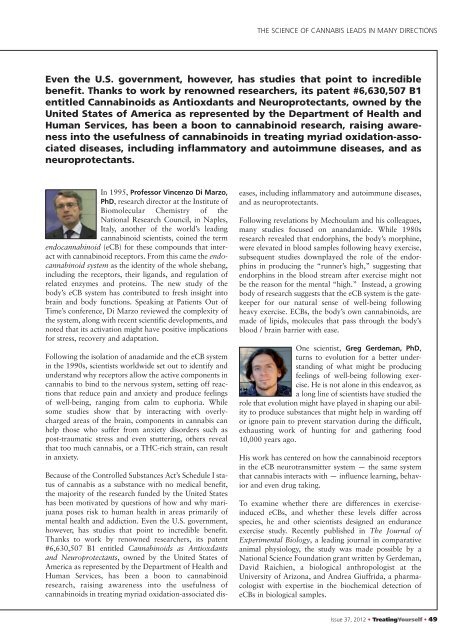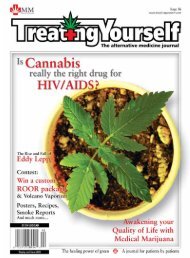Division in the UK Cannabis Movement - Treating Yourself
Division in the UK Cannabis Movement - Treating Yourself
Division in the UK Cannabis Movement - Treating Yourself
You also want an ePaper? Increase the reach of your titles
YUMPU automatically turns print PDFs into web optimized ePapers that Google loves.
THE SCIENCE OF CANNABIS LEADS IN MANY DIRECTIONSEven <strong>the</strong> U.S. government, however, has studies that po<strong>in</strong>t to <strong>in</strong>crediblebenefit. Thanks to work by renowned researchers, its patent #6,630,507 B1entitled Cannab<strong>in</strong>oids as Antioxdants and Neuroprotectants, owned by <strong>the</strong>United States of America as represented by <strong>the</strong> Department of Health andHuman Services, has been a boon to cannab<strong>in</strong>oid research, rais<strong>in</strong>g awareness<strong>in</strong>to <strong>the</strong> usefulness of cannab<strong>in</strong>oids <strong>in</strong> treat<strong>in</strong>g myriad oxidation-associateddiseases, <strong>in</strong>clud<strong>in</strong>g <strong>in</strong>flammatory and autoimmune diseases, and asneuroprotectants.In 1995, Professor V<strong>in</strong>cenzo Di Marzo,PhD, research director at <strong>the</strong> Institute ofBiomolecular Chemistry of <strong>the</strong>National Research Council, <strong>in</strong> Naples,Italy, ano<strong>the</strong>r of <strong>the</strong> world’s lead<strong>in</strong>gcannab<strong>in</strong>oid scientists, co<strong>in</strong>ed <strong>the</strong> termendocannab<strong>in</strong>oid (eCB) for <strong>the</strong>se compounds that <strong>in</strong>teractwith cannab<strong>in</strong>oid receptors. From this came <strong>the</strong> endocannab<strong>in</strong>oidsystem as <strong>the</strong> identity of <strong>the</strong> whole shebang,<strong>in</strong>clud<strong>in</strong>g <strong>the</strong> receptors, <strong>the</strong>ir ligands, and regulation ofrelated enzymes and prote<strong>in</strong>s. The new study of <strong>the</strong>body’s eCB system has contributed to fresh <strong>in</strong>sight <strong>in</strong>tobra<strong>in</strong> and body functions. Speak<strong>in</strong>g at Patients Out ofTime’s conference, Di Marzo reviewed <strong>the</strong> complexity of<strong>the</strong> system, along with recent scientific developments, andnoted that its activation might have positive implicationsfor stress, recovery and adaptation.Follow<strong>in</strong>g <strong>the</strong> isolation of anadamide and <strong>the</strong> eCB system<strong>in</strong> <strong>the</strong> 1990s, scientists worldwide set out to identify andunderstand why receptors allow <strong>the</strong> active components <strong>in</strong>cannabis to b<strong>in</strong>d to <strong>the</strong> nervous system, sett<strong>in</strong>g off reactionsthat reduce pa<strong>in</strong> and anxiety and produce feel<strong>in</strong>gsof well-be<strong>in</strong>g, rang<strong>in</strong>g from calm to euphoria. Whilesome studies show that by <strong>in</strong>teract<strong>in</strong>g with overlychargedareas of <strong>the</strong> bra<strong>in</strong>, components <strong>in</strong> cannabis canhelp those who suffer from anxiety disorders such aspost-traumatic stress and even stutter<strong>in</strong>g, o<strong>the</strong>rs revealthat too much cannabis, or a THC-rich stra<strong>in</strong>, can result<strong>in</strong> anxiety.Because of <strong>the</strong> Controlled Substances Act’s Schedule I statusof cannabis as a substance with no medical benefit,<strong>the</strong> majority of <strong>the</strong> research funded by <strong>the</strong> United Stateshas been motivated by questions of how and why marijuanaposes risk to human health <strong>in</strong> areas primarily ofmental health and addiction. Even <strong>the</strong> U.S. government,however, has studies that po<strong>in</strong>t to <strong>in</strong>credible benefit.Thanks to work by renowned researchers, its patent#6,630,507 B1 entitled Cannab<strong>in</strong>oids as Antioxdantsand Neuroprotectants, owned by <strong>the</strong> United States ofAmerica as represented by <strong>the</strong> Department of Health andHuman Services, has been a boon to cannab<strong>in</strong>oidresearch, rais<strong>in</strong>g awareness <strong>in</strong>to <strong>the</strong> usefulness ofcannab<strong>in</strong>oids <strong>in</strong> treat<strong>in</strong>g myriad oxidation-associated diseases,<strong>in</strong>clud<strong>in</strong>g <strong>in</strong>flammatory and autoimmune diseases,and as neuroprotectants.Follow<strong>in</strong>g revelations by Mechoulam and his colleagues,many studies focused on anandamide. While 1980sresearch revealed that endorph<strong>in</strong>s, <strong>the</strong> body’s morph<strong>in</strong>e,were elevated <strong>in</strong> blood samples follow<strong>in</strong>g heavy exercise,subsequent studies downplayed <strong>the</strong> role of <strong>the</strong> endorph<strong>in</strong>s<strong>in</strong> produc<strong>in</strong>g <strong>the</strong> “runner’s high,” suggest<strong>in</strong>g thatendorph<strong>in</strong>s <strong>in</strong> <strong>the</strong> blood stream after exercise might notbe <strong>the</strong> reason for <strong>the</strong> mental “high.” Instead, a grow<strong>in</strong>gbody of research suggests that <strong>the</strong> eCB system is <strong>the</strong> gatekeeperfor our natural sense of well-be<strong>in</strong>g follow<strong>in</strong>gheavy exercise. ECBs, <strong>the</strong> body’s own cannab<strong>in</strong>oids, aremade of lipids, molecules that pass through <strong>the</strong> body’sblood / bra<strong>in</strong> barrier with ease.One scientist, Greg Gerdeman, PhD,turns to evolution for a better understand<strong>in</strong>gof what might be produc<strong>in</strong>gfeel<strong>in</strong>gs of well-be<strong>in</strong>g follow<strong>in</strong>g exercise.He is not alone <strong>in</strong> this endeavor, asa long l<strong>in</strong>e of scientists have studied <strong>the</strong>role that evolution might have played <strong>in</strong> shap<strong>in</strong>g our abilityto produce substances that might help <strong>in</strong> ward<strong>in</strong>g offor ignore pa<strong>in</strong> to prevent starvation dur<strong>in</strong>g <strong>the</strong> difficult,exhaust<strong>in</strong>g work of hunt<strong>in</strong>g for and ga<strong>the</strong>r<strong>in</strong>g food10,000 years ago.His work has centered on how <strong>the</strong> cannab<strong>in</strong>oid receptors<strong>in</strong> <strong>the</strong> eCB neurotransmitter system — <strong>the</strong> same systemthat cannabis <strong>in</strong>teracts with — <strong>in</strong>fluence learn<strong>in</strong>g, behaviorand even drug tak<strong>in</strong>g.To exam<strong>in</strong>e whe<strong>the</strong>r <strong>the</strong>re are differences <strong>in</strong> exercise<strong>in</strong>ducedeCBs, and whe<strong>the</strong>r <strong>the</strong>se levels differ acrossspecies, he and o<strong>the</strong>r scientists designed an enduranceexercise study. Recently published <strong>in</strong> The Journal ofExperimental Biology, a lead<strong>in</strong>g journal <strong>in</strong> comparativeanimal physiology, <strong>the</strong> study was made possible by aNational Science Foundation grant written by Gerdeman,David Raichien, a biological anthropologist at <strong>the</strong>University of Arizona, and Andrea Giuffrida, a pharmacologistwith expertise <strong>in</strong> <strong>the</strong> biochemical detection ofeCBs <strong>in</strong> biological samples.Issue 37, 2012 • Treat<strong>in</strong>g<strong>Yourself</strong> • 49



